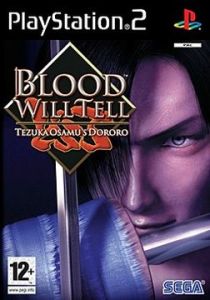Gamestyle Archive intro: did I review this in June 2005? That’s the sign of not a terrible game which would be memorable for all the wrong reasons but rather average. At Gamestyle we were big on scoring average experiences as average hence 5 out of 10. It still frustrates me that most sites score an average game as 7 out of 10, which instead is a very good game. That’s the problem with all scoring as it rigs the whole process and many punters I’m sure skip to the score and don’t follow the reviewers comments.
With so many demons to exorcise, Japanese developers seem hell-bent on dissecting each and every legend, story or piece of pulp fiction that has ever tormented their psyche. Wow Entertainment is the latest to bring us a ferocious tale of a samurai – literally torn apart by demons and sent on a quest for revenge.
Taken from its Manga inspiration, you fill the role of Hyakkimaru, a samurai who has been damned since birth. As the prophesied child of light (aka potential demon slayer), the 48 ruling demons take a great deal of interest in Hyakkimaru’s arrival. And while they cannot prevent his birth, promises of power instead corrupt his family: once the contract is agreed, Hyakkimaru’s father could not envisage the sinister punishment to befall his son. Aware that they could not kill the child, the demons instead took 48 body parts – however, Hyakkimaru’s will to survive was sorely underestimated. Hence, as each demon falls, a body part is restored to the barely-human samurai. Hyakkimaru is initially a puppet-like figure with the frankly bizarre ability to pull off limbs that reveal weapons of varying devastation.
This instantly sets Blood Will Tell apart from other entrants in the samurai-adventure genre: the prologue and immediate missions are handled with aplomb (especially when the restoration of sight returns colour to the screen). But the appeal begins to wane, as Gamestyle realises – along with the player – that in spite of its outdoor decor, inside this is just a generic offering. Linearity soon announces itself, as you are forced along one-way streets and enemies appearing spontaneously. These foot soldiers of evil fall into the category of every other Japanese samurai offering, and are quite dispossessed of intelligence. Once they are harvested, you then face off against one of 48 demons that hold a body part taken from Hyakkimuaru. (At this point, Gamestyle must add that each body part is correctly placed into one of several systems that make up the human body; if anything, Blood Will Tell< actually serves as an educational tool for the ‘bloody’ familiarity it provides – although the game itself rarely bursts a vessel.) The various parts that Hyakkimaru wields improve with each and every kill.
The difficulty is well-placed, but with so many foes offered for slaughter the experience eventually becomes mundane and even futile. Unlike other games where you must seek out confrontations, Blood Will Tell shoves them down your throat; there is no escaping the treadmill of points, as you gradually reach the end (and some sort of peace). Nevertheless, this is a Sega game – and the developer notoriously knows how to entertain gamers. Adding a little spice to the proceedings is a co-operative mode that takes the form of the standard ‘buddy’ dynamic. The faithful sidekick (Dororo) is available for the bloodthirsty missions that make up story mode, but certain junctions require sole possession of the character. These are perhaps the weakest link in the adventure (and an otherwise poor attempt to break up the monotony – as are the incidental mini-games on offer).
At this stage of its lifecycle, Gamestyle would expect Playstation 2 releases to offer solid, well-built environments that show flair or some graphical distinction. Alas, what seemed extraordinary two years ago is somewhat ordinary today – with only the in-game cut sequences rising above and beyond the confines of a dated landscape. Similarly, camera issues again raise their lethargic head: Blood Will Tell quashes the onscreen view of the player by limiting camera control to a 180-degree angle. Normally, one might toggle the right analogue stick for correction, but Blood Will Tell offers a somewhat unorthodox alternative – giving you relative freedom only during boss encounters. But even this ‘freedom’ is hamstrung by repetition. Imagine, if you would, 48 bosses in one game; creating 10 novel bosses would be hard enough, but 48? Gamestyle rests its point. Outside of boss missions, the camera hovers at angles that make close combat unpredictable (as you lunge with hope, rather than precision).
In conclusion, Blood Will Tell falls into the same trap that has ensnared similar releases. It lacks the vital spark to set it apart from others already on the shelf. And, despite the best efforts of its marketing gurus, Blood Will Tell looks set to remain indistinguishable at retail; no doubt inviting but ultimately middling.
Gamestyle Score: 5/10
